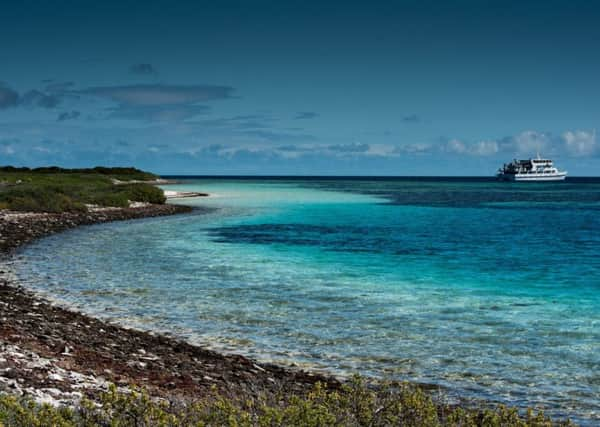Travel: Western Australia's Abrolhos Islands


Listening to calcified coral cracking underfoot, I can almost hear the fragile cries of lost souls buried metres below me. Nearly four centuries ago, 126 men, women and children were massacred during one of the most blood-thirsty episodes in Australia’s maritime history, and many of their bodies were laid to rest here, on Beacon Island.
A local fisherman, Chook, tells me he once spent the night on this “island of angry ghosts”, awaking to the sound of panic-stricken, squawking seabirds.
Advertisement
Hide AdAdvertisement
Hide AdFor now, the windswept, barren coral mound is calm, although a fringe of blood-red fish spawn along the shoreline unintentionally nods to a sinister past.
It’s not an obvious sightseeing attraction, or even one that’s easy to reach, but I’m visiting as part of a small cruise through the relatively unknown Abrolhos Islands. This archipelago of 122 coral and limestone islands strung along the world’s most southerly reef system, 60km offshore from west coast town Geraldton, welcomes only a handful of tourists each year, yet it occupies an important place in Australia’s history.
In 1629, the Dutch merchant vessel Batavia shipwrecked after hitting Morning Reef, which sailors had mistaken for “moonshine on the water”. Of the 322 passengers on board, most managed to swim to shore, although a mutiny reminiscent of Lord Of The Flies ensued.
Hero Wiebbe Hayes eventually reclaimed peace, and the stone forts he erected on West Wallabi Island are considered to be the first European buildings on Australian soil. Providing tidal conditions are favourable, tourists can snorkel or dive the Batavia shipwreck, although up until recently, it’s only been possible to reach with expensive charters or by hitching a ride with a fisherman.
Advertisement
Hide AdAdvertisement
Hide AdA crayfishing industry developed here in the 1920s, with settlements springing up over the course of subsequent decades. But communities collapsed when a quota system was introduced in 2010, meaning it was no longer feasible to fish for more than a few months a year.
Jay Cox, 54, lived on Rat Island for 14 years with his wife, Sonia, and their children. He’s since swapped crayfishing for tourism, and purchased the Eco Abrolhos six years ago, after seeing it for sale in a magazine.
The 38-passenger ship, which formerly operated in the Whitsundays, becomes my cosy home for the next five days. I’m joined on board by a group of 15 hardy, nature-loving Australians, mainly retirees escaping the east coast winter on long caravanning trips.
During our bumpy four-hour sailing from Geraldton, I hear about a 70-year-old vet’s attempts to reintroduce a rare breed of pheasant to New South Wales, and learn how one couple manage to survive for six months a year camping on a beach with just a couple of fishing rods and a biodegradable toilet.
Advertisement
Hide AdAdvertisement
Hide AdAll the while, I’m distracted by migratory humpbacks breaching on the horizon.
Lying in the stream of the Leeuwin Current, the Abrolhos Islands are surrounded by a mixture of tropical and temperate waters making conditions extremely favourable for marine wildlife and a healthy coral reef.
Belts of turquoise and indigo wrap around the islands, melting into each other like butter in a pan. Using the gentle current to carry me, I drift snorkel off the shores of Wooded Island, admiring some of the 100 different types of coral found here. Clownfish eyeball me suspiciously from beneath the writhing tendrils of blue-tipped anemones, as I float below a rooftop of large plate corals.
Those who prefer not to get wet take a scenic trip in glass bottom boat, the King Diver, while others fish for squid. That evening, Chook and Jay’s son, Bronson, fillet snapper and coral trout for dinner as the watery silhouettes of salivating reef sharks gather around the boat.